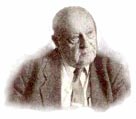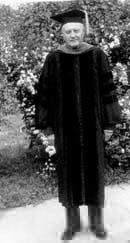Boris Kit
Overview

Boris Vladimirovich Kit is a well-known mathematician, physicist, chemist and educator,
doctor of philosophy in mathematics & in the History of Science.
Boris Kit was born on April 6, 1910 in St. Petersburg, Russia, the son of an employee at
the Post & Telegraph Department, who was Belarusian in origin. In 1918, the family
moved to Belarus, to the village of Ogorodniki – which was his father’s home town (now the
town of Korelichi, Grodno Region). Kit studied at the local Polish school there and later
at the Novogrudok Belarusian High School, where he graduated in 1928.
In 1928, B. Kit entered Vilnia (Vilnius) University, where he studied physics & mathematics. When a student, he had already begun to teach mathematics at the Vilnia Belarusian High School and in 1939 he was appointed Principal of the school. After the Vilnia region had been annexed to Lithuania in late 1939, Kit returned to his native region. He was the Principal of the Novogrudok Belarusian High School there and later a superintendent of a large school system district. Hundreds of elementary schools & several dozen high schools were opened in the region within a year due to Kit’s direct participation. At the same time, Kit also taught mathematics at the Baranovichi Teachers College, but his creative work was interrupted in 1941 by the Second World War.
During the Nazi Occupation of Belarus (1941 – 1944) Kit worked as a teacher in the village of Lebedevo near Molodechno and later as a director of the Postavy Teachers College. He was suspected of having Partisan connections and was arrested by the German SD punitive bodies. He spent a month in prison and was saved from execution by his former pupils. In 1943, Kit became principal of the Molodechno Trade School and it was with great difficulty that he obtained permission from the German authorities to open the school. The students acquired both professional training and a comprehensive knowledge of the history & culture of Belarus. B. Kit did his best to raise the school’s status & to reorganise it into a management and trade college. The school’s curriculum was conducted according to a college programme. This was concealed from the Germans. When they found out about it, Kit was about to be arrested again.
Nevertheless, he delayed fulfilling the German order for closing the school, so that many students were able to finish their course. One of Kit’s students remembers: “The school lacked any political orientation. Hitler and his Army were never praised. Germans never stepped over the school’s threshold. Neither were Stalin and Bolshevism criticised. Everybody understood that the Nazis must be expelled from our land. But in the post-war period, the Soviet authorities severely persecuted the teachers of this type of school. Probably because of this, Kit decided to leave Belarus.”
In 1944, Boris Kit together with his family moved to Germany, first to Offenbach-Lindau in Bavaria, then to Munich. For three years he worked as a teacher of mathematics at the Munich Ukrainian National School. In addition, he studied medicine at Munich University (1945-1948). In late 1948, Kit moved to the small town of South River in the USA, where he worked in the pharmaceutical industry. During this time he actively helped those fellow-Belarusians who happened to be living away from their homeland. In 1950, Kit settled in Los Angeles, where he worked as a chemist in various companies.
In the mid-1950s, Kit began his scientific activities in the field of astronautics. For 25 years he worked in the U.S. space research programme. As a mathematician & systems analyst, he took part in projects aimed at the development of inter-continental rocket systems. He participated in pioneering research & development work for the first American inter-continental, strategic rocket system NAVAHO at the North American Aviation, Inc. (presently Rockwell International Corporation). After the Navaho project was cancelled, he worked in the planning division on several new space projects, which later were used in the Apollo mission to the Moon and on the Shuttle spaceship project.
From 1958, B. Kit worked at the U.S. Air Forces Department, Astronautics Bureau as a state adviser and expert in international astronautics, mainly Soviet. In 1964, B. Kit in collaboration with F. Ordway, published “USSR Space Research and Development.” Boris Kit is the author of the first handbook on rocket propellant, which appeared in 1960. The book became famous and was read throughout the world. It received many positive reviews.
From 1963 Kit worked at the Astronautics Bureau of the International Telephone and
Telegraph Corporation. It was the time when American astronauts were being prepared to fly
to the Moon. Kit was the corporation president’s adviser, and he worked on the
mathematical team supporting the Moon mission.
Later, he worked at the National Bureau of Standards at the U.S. Communication Department,
where he investigated mathematical methods for increasing the administration’s efficiency.
In addition to research, he also taught mathematics at the University of Maryland.
In 1972, B. Kit moved to Frankfurt-am-Main in Germany, where he now lives. He was Professor of Mathematics at the European Division of Maryland University. In 1982, he earned a Ph. D. in mathematics and science history from the University of Regensberg. His doctoral dissertation, which has been published in book form, was dedicated to the life & work of Antoni Zygmund, a distinguished mathematician of the twentieth century. In addition to his educational & research activities, Kit has published over thirty scientific articles in the American & German journals. From 1958, Professor Kit has been a permanent member of all international conferences in astronautics, to which he has contributed many reports and speeches.
 The name of our fellow countryman is widely known today among
the world’s scientific community due to his work in the U.S. space projects. His
contribution to science has been highly praised. He is a long-standing member of the
American Astronautics Society, an honorary member of the German Astronautics Society Board
of Directors, a member of the International Astronautics Academy in Paris, Vice-President
of the Eurasian International Astronautics Academy, and Professor Emeritus of Maryland
University. A “time capsule” with the name of our compatriot was immured in the
wall of Capitol in Washington. That is a symbol of high distinction in the USA and honours
individuals of especially great accomplishments.
The name of our fellow countryman is widely known today among
the world’s scientific community due to his work in the U.S. space projects. His
contribution to science has been highly praised. He is a long-standing member of the
American Astronautics Society, an honorary member of the German Astronautics Society Board
of Directors, a member of the International Astronautics Academy in Paris, Vice-President
of the Eurasian International Astronautics Academy, and Professor Emeritus of Maryland
University. A “time capsule” with the name of our compatriot was immured in the
wall of Capitol in Washington. That is a symbol of high distinction in the USA and honours
individuals of especially great accomplishments.
In the early 1990s, Boris Kit returned to Belarus for the first time for half a century. In the recent years he visited our country several times, despite his great age. On April 6, 2002 he became 92. He has received an Honourary Doctorate of Science from Grodno University. The Belarusian writer and literary critic, Lidia Sivik, wrote two books about his life and work “Return home” and “The Space of the Belarusian.”
The Belarusian State Archives of Scientific and Technical Documentation (Russian acronym BGANTD) began to acquire documents relating to Boris Kit in the autumn of 1993. Between 1994 and 1995, Kit donated a part of his personal collection to the Archives (articles, reports, bibliographic documents.) Some articles, scientific works, letters and the doctoral dissertation from Kit’s archive were provided by the Novogrudok Regional Museum. A number of documents were directly collected by the BGANTD personnel (see articles about Kit and in the book “Return home”.)
Our site offers the material concerning documents held at the BGANTD in the personal archive of Boris Kit (fonds 175, inventory 1), which comprises 54 files totalling 150 documents. The dates of documents cover 1928, 1932-1936, 1939, 1960, 1970-1995.
Information on Boris Kit and the survey of documents from his personal archive was prepared by G. I. Shostak, Head of the BGANTD Preservation Department.

